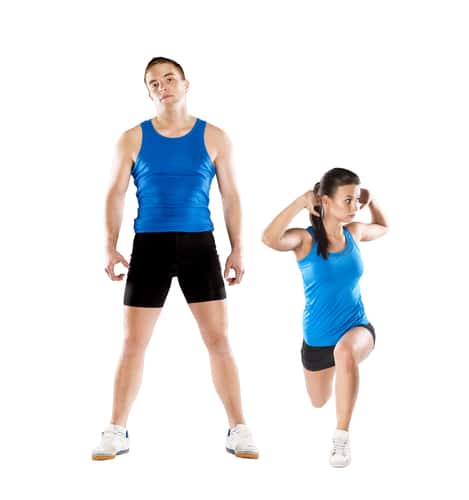
Fortunately, most of us have functional sweat glands that do a pretty good job of keeping us from becoming dangerously overheated, but we’re all a little different and some people sweat more than others. Ever notice how men are drenched in sweat when they work out while women stay dryer? Are there differences in the way men and women sweat?
Men and Women: Do They Sweat Differently?
Men and women DO appear to sweat at different rates even when they work out at the same exercise intensity. In one study researchers had a group of Japanese male and female participants pedal an exercise bike in a hot and humid lab for an hour. The participants started out at a low intensity, but the intensity of their ride was gradually increased until the participants were exercising at 65% of their V02 max. During the session, researchers measured their sweat output.
What they found was that the men, whether trained or untrained, sweated more than women at the same exercise intensity. Even though the women had a similar number of sweat glands, each of their sweat glands produced less sweat relative to a man’s at the same core body temperature. So, women may be at a disadvantage when it comes to cooling their body during exercise.
How soon men and women begin to sweat during exercise varies with their level of fitness and training. Trained, fit individuals who exercise regularly sweat sooner and sweat more than those who are untrained. Therefore, women who are less fit generally sweat the least while men who are the most fit sweat the most.
Why Do Men Sweat More Than Women?
Differences in sweat rates between men and women seem to have more to do with hormones than sweat glands. Despite the fact that both sexes have roughly equal numbers of sweat glands on average, men produce more sweat per gland. The reason? Experts believe it can be explained by the fact that men have more testosterone. Research shows testosterone enhances the sweating response, causing earlier and more profuse sweating. Men have higher levels of testosterone both at rest and during exercise. The fact that women have higher levels of estrogen than men may play a role too. Estrogens raise the threshold at which sweating occurs so sweating doesn’t occur until a higher core body temperature is reached.
Is Age a Factor?
Before puberty, boys and girls have a similar sweat response to exercise, but as boys go through puberty and testosterone increases, their sweat glands become more active and they sweat more than girls as a generalization.
As both men and women age, their risk for overheating during exercise increases as sweat glands become less efficient, blood to the surface of the skin to release heat decreases and it becomes more difficult for the body to maintain fluid balance. That’s why it’s important for everyone, but particularly older men and women, to stay hydrated.
Are Women at Greater Risk for Dehydration and Heat-Related Illness?
Sweating is a good thing when it comes to exercise performance and safety since it lowers core body temperature and reduces fatigue and the risk of overheating. Since women don’t sweat as quickly or as profusely, they may be at a disadvantage when exercising in the heat. That’s why it’s important to wear light clothing and stay hydrated. Women are at greater risk for dehydration during exercise since they have lower body fluid levels than men.
The good news is women become “better sweaters” as their fitness level increases. With greater fitness, women begin to sweat at a lower core body temperature and are better able to release excess heat more effectively. With greater fitness, both men and women lose less sodium through sweat despite sweating more. This is one of the many adaptations to regular exercise. To maximize these benefits, you have to exercise in a hot environment or exercise at an intensity high enough to significantly raise your core body temperature. Another adaptation that occurs is an increase in plasma volume. This rise in plasma volume, marked by an increase in plasma proteins, helps your body store more heat without raising your core body temperature.
The Bottom Line?
In general, men sweat more during exercise and begin sweating at a lower core body temperature than women. Training is a factor too. Fitter individuals, both male and female, and those who are heat acclimated sweat sooner and sweat more than untrained people. Contrary to popular belief, it’s not unfit people who sweat the most – it’s those who are fit. Most importantly, make sure you stay hydrated.
References:
Exp Physiol. 2010 Oct;95(10):1026-32.
Fertil Steril. 2002 Mar;77(3):487-90.
Texas A & M. “August 2008 – Vol. 12, No. 8. How Do Our Bodies Adjust to Heat across the Ages?
Exercise Physiology: Theory and Application to Fitness and Performance. Powers and Howley. Seventh edition.
Related Articles By Cathe:
What Determines How Much You Sweat During a Workout?

